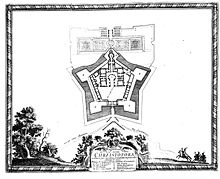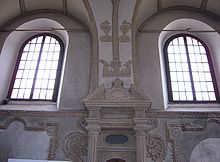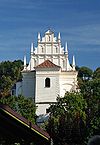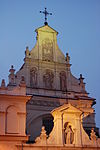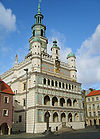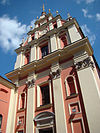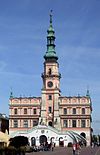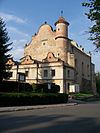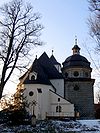- Mannerist architecture and sculpture in Poland
-
Mannerist architecture and sculpture in Poland dominated between 1550 and 1650, when it was finally replaced with baroque.[1] The style includes various mannerist traditions,[1] which are closely related with ethnic and religious diversity of the country, as well as with its economic and political situation at that time. The mannerist complex of Kalwaria Zebrzydowska and mannerist City of Zamość are UNESCO World Heritage Sites.[2][3]
Contents
Conditions of development and features
The period between 1550 and 1650 was a Golden Age of the Polish–Lithuanian Commonwealth (created in 1569) and a Golden Age of Poland.[4] It was a time of economic prosperity due to grain trade.[5] Grain was kept in richly embellished granaries (e.g. in Kazimierz Dolny) and transported along the Vistula to the main port of Poland - Gdańsk, where it was sold to the Netherlands, England, France, Italy and Spain (about 80% of the city's revenues in the beginning of the 17th century came from grain trade).[5][6] It was also the time of religious tolerance due to the Warsaw Confederation (1573).[7]
Poland was multinational (Poles, Ruthenians, Jews, Germans, Italians, Dutch, Flemish, Armenians, Scots, Bohemians, Tatars) and multi-religious country (Roman Catholics, Orthodox, Greek Catholics, Calvinists, Lutherans, Muslims, Polish Brethren, Hussites and many others).[8][9] All those nations and worships contributed to creation of the exceptional diversity of mannerist architecture and sculpture in Poland. The first half of the 17th century is marked by strong activity of the Jesuits and Counter-Reformation, which led to banishing of progressive Arians (Polish Brethren) in 1658 and which has its reflection in architecture (spread of baroque). Despite that Poland remain a "country without stakes".[7][10] All the major wars and military conflicts were conducted far from the territory of today's Poland, so the country could developed equally. Those favorable conditions are the reason why mannerist architecture and sculpure in Poland left so many beautiful examples.
The mannerist architecture and sculpture have two major traditions - Polish/Italian and Dutch/Flemish, that domniated in northern Poland.[11] The Silesian mannerism of South-Western Poland was largely influenced by Bohemian and German mannerism, while the Pomeranian mannerism of North-Western Poland was influenced by Gothic tradition and Northern German mannerism. The Jews in Poland adapted patterns of Italian and Polish mannerism to their own tradition.[12]
Major inspiration for many structures in Poland were early renaissance constructions at Wawel Hill - Sigismund's Chapel (1519–1533), Tomb of king Sigismund I inside the chapel (1529–1531) and Wawel Castle's arcade courtyard (1506–1534), as well as buildings in Antwerp - City Hall (1561–1565), houses at Grote Markt and funeral sculptures by Cornelis Floris de Vriendt. In conclusion the main criterion of differentiation between types of mannerism in Poland is the source of inspiration and in many cases the founders conception played an essential role for the final shape of the construction (e.g. Tomb of Jędrzej Noskowski in Maków Mazowiecki by Willem van den Blocke, is an example of Polish mannerism inspired by Tomb of Sigismund I with a founder depicted sleeping).[13]
Triangle gables of late gothic origin and large windows are the features of Dutch urban architecture in Northern Poland. The Polish mannerism, though largely dominated by Italian architects and sculptors, has its unique characteristics that differentiate it from its Italian equivalent (attics, decorational motives, construction and shape of buildings, Dutch, Bohemian and German inflences).[11] Among notable architects and sculptors of Dutch/Flemish mannerism in Poland were Anthonis van Obbergen, Willem van den Blocke, Abraham van den Blocke, Jan Strakowski, Paul Baudarth, Gerhard Hendrik, Hans Kramer and Regnier van Amsterdam and of Polish/Italian mannerism Santi Gucci, Jan Michałowicz of Urzędów, Giovanni Maria Padovano, Giovanni Battista di Quadro, Jan Frankiewicz, Galleazzo Appiani, Jan Jaroszewicz, Bernardo Morando, Kasper Fodyga, Krzysztof Bonadura, Antoneo de Galia and many others.
The architecture of the 16th century Polish mannerism is marked by common usage of richly embellished attics of palaces and houses, arcade courtyards and side towers.[11] The church architecture combined the late gothic tradition with renaissance symmetry and mannerist decoration. Churches were slender, usually without towers. The 17th century Polish mannerism characterize with much more simplicity in decoration in benefit to harmony of the construction. The model to the early 17th century residencies were royal palaces. Ujazdów Castle constructed for king Sigismund III Vasa was possible inspiration to the Bishop Palace in Kielce,[14] whereas the Kielce palace was imitated by many magnate families in their residencies (e.g. Tarło Palace in Podzamcze, 1645-1650[15] and Radziwiłł Palace in Biała Podlaska). This type of the palace is known as Poggio–Reale because it combined a square building with a central loggia with side towers as in Poggio–Reale Villa near Naples (1487–1489) according to conception of Baldassare Peruzzi and Sebastiano Serlio.[16] Side towers become an obligatory element of every palace and funeral church chapels, modelled after mentioned Sigismund's Chapel, flourished all over Poland (Staszów, Włocławek). Another characteristics of the mannerism in Poland are city and palace fortifications built in Dutch style[17] (Zamość, Ujazd) and town halls with high towers (Biecz, Zamość, Poznań). The most popular decoration techniques were relief (Kazimierz Dolny), sgraffito (Krasiczyn) and rustication (Książ Wielki), whereas the material was mainly brick, plastered brick, sandstone and sometimes limestone. For some time the late renaissance coexisted with early baroque (introduced in Poland in 1597 with Church of SS. Peter and Paul in Kraków).[18]
Dutch/Flemish and Polish/Italian architectural traditions were not isolated and penetrate each other to create (among others) a unique composition of Krzyżtopór Palace.[19] This, one of the largest constructions of mannerism and early baroque in Poland, was intended as a fortified palace (type known in Poland under Italian name palazzo in fortezza).[19] The complex combined Dutch style fortifications with a palace built to Italian design (inspirations of Palazzo Farnese in Caprarola are visible in the plan of the complex), mannerist Polish decoration and some other, presumably Dutch elements (octagonal tower resembling Binnenhof's Torentje in The Hague, spires). The palace was destroyed during the Deluge and currently remains in ruins.
Lublin region created its own style with folk motives (Kazimierz Dolny), while the urban mannerism in Greater Poland replaced the gothic gables with Italian style arcades, tympanums, friezes and pillars in tuscan order (Poznań). Warsaw, as one of the main cities of the Polish-Lithuanian Commonwealth and due to its role as seat of Parliament and King, was a place of meetings of cultures.[20] The mannerist architecture in the city was a combination of many types of mannerist traditions, including Lublin type (Jesuit Church), Greater Poland mannerism (Kanonia), Italian mannerism with elements of early baroque (Royal Castle), Lesser Poland mannerism (Kryski Chapel), Poggio–Reale type (Villa Regia Palace - not existing), Bohemian and Dutch mannerism (Ossoliński Palace - not existing, possible inspiration to palace's upper parts pavilion with characteristic roof was Bonifaz Wohlmut's reconstruction of Belvedere in Prague, 1557–1563).
The Bohemian mannerism had also large inflence on the architecture and sculpture in Poland.[21] This concerned not only the lands that were part of the Kingdom of Bohemia, like Silesia.[21] The familiar relations between the Habsburgs and the Polish Vasas enabled to draw form the patterns of Prague mannerism. Both king Sigismund III and his son Władysław IV Vasa as well as magnates purchased many sculptures in Prague, especially those by Adriaen de Vries.[22] Bohemian mannerism in Silesia joined the Prague renaissance with its brunelleschian arcades (inspired by Queen Anna Jagiellon's Belvedere in Prague, 1535–1537) and German inflences originating from the late gothic (steep gable with renaissance decoration). Also Silesian mannerism had its impact on neighbouring regions - the arcade courtyard of the Piast Castle in Brzeg with arcades replaced in upper parts with columns (constructed by Francesco de Pario, 1556–1558) was possible inspiration for similar constructions in Bohemia - Opočno Castle (1560–1567), Jindřichův Hradec Castle (loggia, before 1597) and Schloss Güstrow in Germany (built by Pario after 1558).[23]
Characteristic for Jewish mannerism in Poland is adjustment of the Polish/Italian patterns to the Jewish tradition, rejection of human images in benefit to the sophisticated floral-animal decorations (tendrils, lions), mythological creatures (unicorns, griffins) and Hebrew inscriptions.[12] The synagogues were adorned with horizontal attics (Zamość) or had a richly decorated interior (Pińczów). The main decorating techniques were fresco (Tykocin, Pińczów), relief and stucco (Zamość).[12]
The sculpture is mainly represented in sepulchral art and decorations of facades. Free standing sculptures are rare, though before the Deluge gardens of many residencies were adorned with sculptures (e.g. Villa Regia Palace's garden in Warsaw was embellished with sculptures by Adriaen de Vries).[16][22] Also the free standing tomb monuments were uncommon. The tombs were generally constructed to be attached to the wall, exception is the Niedrzwicki Brothers Tomb in Koprzywnica. During the first stage of mannerism in Poland the tomb monuments were constructed according to the early renaissance tradition, where the deceased was depicted sleeping.[24] They were generally made of sandstone, while the founder's figure was carved in red marble (e.g. Tarnowski Tomb in Tarnów Cathedral). In the beginning of the 17th century Dutch architects and sculptors (especially Willem van den Blocke and his son Abraham) popularised in Poland new type of tomb monumet[25] originating from the Cornelis Floris workshop (e.g. not existing Tomb of duke Albert of Prussia in the Königsberg Cathedral). The founders were depicted kneeling, the construction was more spacious and it employ darker materials - brown marbles from Chęciny, black marbles from Dębnik or imported from the Spanish Netherlands (e.g. Tomb of Báthory brothers in Barczewo). Some of the most impressive Dutch style tombs in Poland were constructed far from the center of Dutch mannerism in Poland - Gdańsk.[26] These were tombs of Jan Tarnowski in Łowicz (1603–1604) and of Ostrogski family in Tarnów (1612–1620).
Many of the mannerist structures in Poland are postwar reconstructions. They were destroyed by the Germans during the World War II (e.g. all mannerist constructions in Warsaw, many Jewish pray houses) or damaged in Allied aerial bombings (Gdańsk, Wrocław).[27] Also many were not restored after the war (e.g. tomb monument of transylvanian secretary of king Stephen Báthory, Márton de Berzeviczy by Willem van den Blocke in Lisnowo, destroyed by the Germans in 1939;[13] tomb monument of Wolski Brothers in Warsaw by Jan Michałowicz destroyed in 1944;[28] or Tarnów Synagogue, destroyed in 1939).[29]
List of notable mannerist structures in Poland
Northern Poland
Main article: List of mannerist structures in Northern PolandPlace Building Date of construction Style and history Image Chełmno Town Hall 1567–1572 Dutch/Polish mannerism. The original building was built in 1298. The tower was added between 1584-1596.[30] Architecture of the building had many influences - horizontal attic embellished with volutes is characteristic for Polish mannerism, the elevated gables and soaring windows are in Dutch style and tower decorated with corner rustication is typical for similar structures in Germany. Gdańsk Golden House 1609–1618 Dutch mannerism (architect Abraham van den Blocke).[31] Built for Johann Speymann, a wealthy grain trader and mayor of the city, and his wife Judith Bahr. The attic is decorated with sculptures depicting Cleopatra, Oedipus, Achilles and Antigone by Johann Vogt of Rostock. Golden Gate 1612–1614 Dutch mannerism (constructed by Jan Strakowski to design by Abraham van den Blocke).[32] The attic was adorned with allegorical sculptures of citizen’s virtues: Peace, Liberty, Fortune and Fame (west side), Harmony, Justice, Piety and Prudence (east side).[32] They were carved in 1648 by Peter Ringering to Jeremias Falck's design. Green Gate 1564–1568 Flemish mannerism, inspired by the Antwerp City Hall (architect Regnier van Amsterdam).[31] It was built to serve as the formal residence of the Polish monarchs.[33] Neptune's Fountain 1617 Dutch mannerism (design by Abraham van den Blocke).[34] The fountain was founded by the city councillors at Barthell Schachtmann's initiative.[35] The Neptune's statue was cast in Augsburg by Peter Husen and Johann Rogge. In 1634 the fountain was encompassed by a fence decorated with gilded Polish Eagles, also designed by Abraham van den Blocke.[35] Old Arsenal 1602–1605 Dutch/Flemish mannerism (architects Anthonis van Obbergen, Jan Strakowski and Abraham van den Blocke).[36] Schumann House 1560 Flemish mannerism.[31] Built for Hans Conert the Younger by unknown architect. The building was known at that time as the King's House.[37] The top of the house is decorated with the sculpture of Zeus. Schumann House's architecture bears strong resemblance to Gildehuis der Kuipers (Coopers' House) and to Huis van de Schutters (Archer's House) in Antwerp. St. Mary's Church - Epitaph of Edward Blemke 1591 Dutch mannerism (sculptor Willem van den Blocke).[38] The central relief depicts the resurrection in the Valley of Josaphat according to prophet Ezekiel's vision (the dynamic of skeletons' transformation from bones to corpse is exceptional).[38] The epitaph was crowned with a sculpture of death. Inspiration were epitaphs by Cornelis Floris - the construction bears resemblance to Epitaph of Dirk van Assendelft and his wife Adriana van Nassau in Grote Kerk in Breda (1555). Oliwa Oliwa Cathedral - Kos Tomb 1599–1620 Dutch mannerism (sculptor Willem van den Blocke). Established by Mikołaj Kos, landlord in Żukczyn.[39] Mikołaj and his son Andrzej were depicted wearing armours of Polish hussars.[39] Szczecin Pomeranian Dukes Castle 1573−1582 Pomeranian mannerism (architect Wilhelm Zachariasz Italus).[40] The original castle (built in 1346 by duke Barnim the Great) was rebuilt in the late renaissance style for duke John Frederick.[41] Włocławek Włocławek Cathedral - Chapel of the Blessed Virgin Mary 1604–1611 Polish mannerism. Originally built in 1503, it was reconstructed in the mannerist style by bishop Jan Tarnowski.[42] The architecture of the chapel, though inspired by Sigismund's Chapel was adapted and transformed according to Dutch patterns. The dome was hidden behind the balustrade and the walls were covered with a subtle corner rustication. Central Poland
Main article: List of mannerist structures in Central PolandPlace Building Date of construction Style and history Image Drobin Church of Our Lady of the Rosary and St. Stanisław - Kryski Tomb 1572–1576 Italian/Polish mannerism (circle of Santi Gucci).[43] Established by Stanisław Kryski, voivode of Masovia. It depicts Stanisław's parents Paweł Kryski, his wife Anna Szreńska and their son Wojciech Kryski, chamberlain of Płock.[43] The structure was by most account inspired by the tombs in the Medici Chapel in the Basilica of San Lorenzo in Florence and The tomb of Julius II in the San Pietro in Vincoli Basilica in Rome, designed by Michelangelo.[43] Gołąb Church of St. Catherine and St. Florian 1628–1638 Polish mannerism (circle of Santi Gucci) with elements of Dutch mannierism (ferrule ornament).[44] The church was established by priest Szymon Grzybowski.[44] Loreto House 1634–1642 Italian mannerism, an exact replica of the Loreto House in Italy.[44] Founded by Chancellor Jerzy Ossoliński.[44] The main decorating features are ceramic statues of prophets, created under strong influence of Michelangelo's works.[44] Kazimierz Dolny Celej House before 1635 Polish mannerism (Lublin type, circle of Santi Gucci), the attic is decorated with folk motives (basilisks, dragons and birds among others)[45] Built for a wealthy merchant Bartłomiej Celej. Church of St. John the Baptist and St. Bartholomew 1586–1613 Polish mannerism (architect Jakub Balin). The original 14th century building burned in 1561.[46] The initiators of the reconstruction and the founders were the Firlejs.[46] The church was enhanced and covered with a cradle vault with lanterns. The gothic gables were rebuilt in the late renaissance style.[46] Mikołaj Przybyła Granary 1591 Polish mannerism. In the beginning of the 17th century there was about 60 granaries in the town.[47] Przybyła Houses 1615 Polish mannerism (Lublin type with folk motives).[48] Built for two brothers Mikołaj and Krzysztof Przybyła.[48] Lublin Carmelite Church 1635–1644 Polish mannerism (Lublin type).[49] The church was founded by Katarzyna z Kretków Sanguszkowa for Discalced Carmelite Sisters.[49] The main gabled fasade was decorated with arcade-pilaster divisions and frescoes. Nave elevations were divided with pilasters supporting the console cornice.[49] Konopnica House 1575 Polish mannerism. The original late gothic house (built before 1512) was obtained by Sebastian Konopnica as a dowry of his wife Katarzyna z Kretków.[50] Konopnica, city mayor of Lublin, rebuilt the house in mannerist style.[50] Rich decorations of windows with medallions bearing effigies of Sebastian Konopnica and his wife Katarzyna are attributed to Pińczów workshop.[50] Pabianice Manor house 1565–1571 Polish mannerism (architect Wawrzyniec Lorek). Built for canon Stanisław Dąbrowski.[51] Poznań City Hall 1550–1567 Italian/Polish mannerism (architect Giovanni Battista di Quadro). The town hall was built during the turn of the 13th and 14th centuries.[52] In the 16th century the building was enhanced, roofs were covered with attics and facade was embellished with a three-story loggia.[52] Poznań Cathedral - Tomb of bishop Izdbieński 1557–1560 Polish mannerism (sculptor Jan Michałowicz of Urzędów). It was established for Benedykt Izdbieński, bishop of Poznań by his heirs. The tomb was carved in sandstone and red marble and adorned with profuse floral decorations.[53] Characteristic for Michałowicz blend of Flemish and Italian inflences is visible in the tomb.[53] Ridt House 1576 Polish mannerism (Greater Poland type, architect Giovanni Battista di Quadro).[54] The gothic building was purchased in 1566 by Zachariasz Ridt, a rich cloth and leather merchant.[54] Zachariasz, who was also a senior pastor of the Lutheran community in Poznań, rebuilt the house in mannerist style.[54] The tuscan order, decorational features of the gable (volutes and pillars) as well as division of facade surfaces with simple details are typical for Greater Poland mannerism. Siedlisko Schönaich Castle 1597–1618 German mannerism (architect Melchior Duckhardt). The original wooden castrum in Sedlscho was replaced between 1550-1560 by a brick building.[55] It was later enlarged and reconstructed for Georg Schönaich, who also built a chapel (Protestant rood screen) with mannerist decorations.[55] Uchanie Church of the Assumption of Mary - Uchański Tomb c. 1607 Polish mannerism (sculptor Santi Gucci).[56] Established by Anny Herburtówna to commemorate herself and her husband Paweł Uchański, voivode of Bełz.[56] Made of sandstone with marble incrustatins, adorned with profuse floral and animal decorations. The effigies of the deceased were carved in alabaster.[56] Warsaw Jesuit Church 1609–1626 Polish mannerism (Lublin type, architect Jan Frankiewicz).[57] The church was founded by King Sigismund III Vasa and a chamberlain Andrzej Bobola (the Old) at Piotr Skarga's initiative, in 1609. Negro House 1622–1628 Polish mannerism. The reconstruction of the gothic house (built before 1449) in the mannierist style was started by Jana Kluga and accomplished by Jakub Gianotti, who get a special tax exemption for this undertaking from the city municipalities.[58] The facade was adorned with two richly decorated portals and a medallion with effigy of Negro, attributed to Gucci's workshop.[59] This sculpture gave its name to the house.[59] One of the portals bears a mark of ownership (gmerk) with initials 'IG' of Jakub Gianotti.[59] Royal Castle 1598–1619 Polish mannerism/early baroque (architect Giovanni Battista Trevano - his plans were probably amended by Vincenzo Scamozzi).[60] The original castle, built between 1407–1410, was expanded for king Sigismund III Vasa by a group of Italian architects and sculptors, including Giacomo Rodondo, Paolo del Corte and Matteo Castelli. Zamość Armenian Houses No. 30-26 first half of the 17th century Polish mannerism. No. 30 (green) - rebuilt in 1665-1674 for Jan Wilczek and adorned with profuse floral-animal motives, No. 28 (dark yellow) - built in 1645-1647 for Bazyli Rudomicz professor of the Zamojski Academy, No. 26 (red) - built in 1632-1634 for Armenian merchant Gabriel Bartoszewicz.[61] Cathedral 1587–1637 Polish mannerism (Lublin type, architect Bernardo Morando).[62] It was constructed as a three-nave basilica with side chapels.[62] The main 20m high nave was covered with a cradle vault with lanterns. The naves are divided by thick corinthian pillars crowned with richly decorated entablature. Vaults were embellished with moldings (geometric, floral and figural motives).[62] Synagogue 1610–1620 Jewish mannerism.[12] Built for the Sephardi Jews. The interior was richly decorated with stucco in Kalisian-Lublin style. The main part was a great pray hall (11.5 x 12.2 m).[63] Town Hall 1591–1622 Polish mannerism (architect Bernardo Morando). Between 1639-1651 it was rebuilt by Jan Jaroszewicz and Jan Wolff.[64] The building was enlarged and enhanced by adding another storey with high mannerist attic, while the horseshoe shaped staircase is an 18th century addition.[64] The clock tower is 52 meters tall and consist of five levels on square and octagonal plan. Southern Poland
Main article: List of mannerist structures in Southern PolandPlace Building Date of construction Style and history Image Baranów Sandomierski Leszczyński Castle 1591–1606 Polish mannerism (circle of Santi Gucci).[65] The castle was built for Rafał Leszczyński and his son Andrzej as a fortified palace (palazzo in fortezza).[65] The architecture of the castle merge all the characteristics of Polish mannerism - side towers, arcade courtyard and richly decorated attic. Brzeg Piast Castle Courtyard 1556–1558 Silesian mannerism (architect Francesco de Pario of Bissone). The original gothic castle was rebuilt for Jerzy II the Magnificent, duke of Brzeg and Legnica.[66] It was probably inspired by Wawel Castle courtyard.[67] The architecture of the castle's arcades bears strong resemblance to Opočno Castle in the Czech Republic and Schloss Güstrow in Germany. Piast Castle Gate 1554–1560 Silesian mannerism. The gate was adorned with profuse mannerist reliefs and sculptures of Jerzy II and his wife Barbara of Brandenburg.[67] The busts depicts 24 Piasts, ancestors of Jerzy II - 12 rulers of Poland from the legendary Piast the Wheelwright to Władysław II the Exile and 12 dukes of Silesia from Henry I the Bearded to Frederick II of Legnica.[67] The inspiration for this decoration were woodcuts from the 1521 Chronica Polonorum by Maciej Miechowita.[67] Jarosław Orsetti House 1570–1593, 1646 Polish mannerism. Built for Stanisław Smiszowic, Jarosław's apothecary.[68] In 1633 the building was purchased by Wilhelm Orsetti and rebuilt in 1646.[68] Kalwaria Zebrzydowska Ecce Homo Chapel 1605–1609 Dutch mannerism (architect Paul Baudarth). It was built on the plan of the Greek cross. The vault adorned with profuse stucco decorations in the style of Dutch mannerism.[69] Kielce Bishops’ Palace 1637–1644 Italian/Dutch mannerism (architect Tommaso Poncino).[14] The palace was established by Jakub Zadzik, bishop of Kraków. The building was inspired by the royal residences in Warsaw and modelled in the so-called Poggio–Reale style.[14] Steep roofs, towers and decorations are Dutch style features. Kraków Ciborium in St. Mary's Basilica 1552 Polish mannerism (sculptor Giovanni Maria Padovano).[70] The St. Mary's Basilica's Ciborium was established by Kraków's goldsmiths Andrzej Mastelli and Jerzy Pipan.[70] It was made of sandstone and adorned with red Salzburg marble, alabaster and stucco. A cast bronze balustrade was created in 1595 by Michał Otto and decorated with Polish and Lithuanian coat of arms.[70] Decjusz Villa 1630 Italian mannerism (architect Maciej Trapola).[71] The original villa, built between 1528-1535 for Justus Decjusz, was rebuilt for Sebastian Lubomirski.[71] Inspiration for this reconstruction was a renaissance treaty by Sebastiano Serlio.[71] Holy Trinity Church - Gonzaga-Myszkowski Chapel 1603–1614 Polish mannerism/early baroque (architect Santi Gucci), decorated with rustication. The chapel was modelled after the Sigismund's Chapel (1519–1533). It was founded by Zygmunt Gonzaga-Myszkowski (together with his brother Piotr, he was adopted in 1597 by Vincenzo Gonzaga, Duke of Mantua).[72] Prelate House 1618–1619 Polish mannerism (architects Maciej Litwinkowicz and Jan Zatorczyk).[73] The characteristics are late renaissance attic by Zatorczyk (1625) and sgraffito decoration imitating diamond-pointed rustication.[73] Wawel Cathedral - Stephen Báthory Tomb 1594–1595 Polish mannerism (sculptor Santi Gucci). Established by Queen Anna Jagiellon to commemorate her husband Stephen Báthory.[74] Made of sandstone, red marble and alabaster.[74] Krasiczyn Krasicki Palace 1580–1631 Polish mannerism (architect Galleazzo Appiani).[75] The construction was started by Stanisław Krasicki and accomplished by his son Marcin Krasicki, voivode of Podolia. It was built as a fortified palace.[75] Each tower of the Krasicki Palace is different and both inner and the outer facades were decorated with profuse sgraffitos (they cover more than 7000 square meters in total).[75] Książ Wielki Mirów Palace 1585–1595 Polish mannerism (architect Santi Gucci). Founded by Piotr Myszkowski, bishop of Cracow as a fortified palace (palazzo in fortezza).[76] The palace is decorated with rusticated stonework.[76] Lesko Fortified Synagogue 1626–1654 Jewish mannerism.[77] The facade bears a Hebrew inscription that reads: He was afraid and said, "How awesome is this place! This is none other than the house of God; this is the gate of heaven." (Genesis 28:17)[78] Oleśnica Ducal Castle 1585–1608 German mannerism (architect Bernard Niuron).[79] The original gothic castle (built by duke Konrad I of Oleśnica) was successively enlarged and rebuilt by the powerful bohemian magnats the Poděbrads.[79] The reconstruction in mannerist style began in 1585. Duke Charles II built a new eastern and southern wings. He also rebuilt the so-called Widow Palace. The courtyard was emebllished with characteristic balconies and the main gate portal was adorned with Silesian and Poděbrad family crests.[79] Pińczów St. Anne's Chapel 1600 Polish mannerism (architect Santi Gucci).[80] The building was established by Zygmunt Gonzaga-Myszkowski, marquess in Mirów to commemorate a Jubilee of 1600.[80] Przemyśl Carmelite Church 1624–1630 Polish mannerism (architect - probably Galleazzo Appiani).[81] The church was founded in 1620 by Marcin Krasicki, starost of Przemyśl and owner of Krasiczyn.[81] The construction started in 1630 and was conducted by master craftsman Ligęski of Przemyśl.[81] Przemyśl Cathedral - Fredro Tomb after 1622 Polish mannerism. The tomb monument was constructed for Jan Fredro, castellan of Przemyśl and his wife Anna ze Stadnickich.[82] It was carved in limestone and alabaster in tuscan order.[82] The top of the tomb is decorated with a sculpture of archangel Michael. Staszów Church of St. Bartholomew - Tęczyński Chapel 1618–1625 Polish mannerism (Pińczów workshop, circle of Santi Gucci).[83] Tęczyński Chapel was founded by Katarzyna Leszczyńska to commemorate her husband Andrzej Tęczyński, castellan of Bełz and son Jacek.[83] The chapel was modelled after the Sigismund's Chapel and decorated with rustication.[83] Sucha Beskidzka Komorowski Castle 1608–1614 Polish mannerism (architect - probably Paul Baudarth). The original defensive mansion built between 1554-1580 was enlarged and rebuilt for Piotr Komorowski.[84] Tarnów Tarnów Cathedral - Ostrogski Tomb 1612–1620 Dutch mannerism (design by Willem van den Blocke). Established by Janusz Ostrogski, voivode of Volhyn.[85] Made of black and red marble and yellow alabaster. It depicts the kneeling figures of the founder and his first wife Zsuzsanna Serédi of Felsőnovaj.[85] The monument was enlarged using the trompe-l'œil technique.[85] Ujazd Krzyżtopór 1621–1644 Polish mannerism/early baroque (architect Wawrzyniec Senes of Sent). The palace was built for Krzysztof Ossoliński as a fortified palace with bastions on plan of a regular pentagon. Krzyżtopór has 4 towers (seasons of the year), 12 halls (months), 52 chambers (weeks of the year) and 365 windows (days of the year).[86] Wrocław House of the Griffins 1587–1589 German/Dutch mannerism (architect Friedrich Gross).[87] It is the largest merchant house in Wrocław (16.25m wide), originally built in about 1300.[87] The house was rebuilt for Daniel von Turnau und Kueschmalz and his wife Dorothea von Matte. The mannerist portal with founders' crests was carved by Gerhard Hendrik of Amsterdam.[87] The house was named after griffins decorating the attic.[87] Żórawina Holy Trinity Church 1600–1608 German/Dutch mannerism. The 14th century church was reconstructed in mannerist style at Adam von Hanniwaldt's initiative. The undertaking was financially supported by Adam's brother Andreas, councillor at the court of Emperor Rudolph II. Among the artists employed in decoration of the church were eminent Dutch sculptors Adriaen de Vries and Gerhard Hendrik.[88] Not existing structures
Place Building Date of construction Style and history Image Elbląg Artus Court 1578–1581 Dutch mannerism (architect Hans Schneker of Lindau).[89] The building of the St. George Guild was established and financed by the members of the guild.[89] The official inauguration of the new abode occurred in 1583. It served as a place of meetings of merchants, receptions and performances.[89] The facade of the house represented typical for Dutch mannerism merge of stone and brick elements. Warsaw Town Hall 1580 Polish mannerism (architect Antoneo de Ralia).[90] It was rebuilt between 1620-1621.[90] The architecture of the building was similar to many other structures of that type in Poland. It was adorned with attic and four side towers. Clock tower, embellished with an arcade loggia, was covered with a bulbous spire typical for Warsaw mannerist architecture (e.g. Royal Castle, not existing timber manor house of Opaliński family in Warsaw New Town).[91] See also
References
- ^ a b (Polish) Tadeusz Dobrowolski, Helena Blumówna (1965). Historia sztuki polskiej (History of Polish art). Wydawnictwo Literackie. p. 44, 346.
- ^ (English) "Kalwaria Zebrzydowska: the Mannerist Architectural and Park Landscape Complex and Pilgrimage Park". whc.unesco.org. http://whc.unesco.org/en/list/905. Retrieved 2009-12-28.
- ^ (English) "Old City of Zamość". whc.unesco.org. http://whc.unesco.org/en/list/564. Retrieved 2009-12-28.
- ^ (English) Andrzej Borowski (2007). Iter Polono-Belgo-Ollandicum: cultural and literary relationships between the Commonwealth of Poland and the Netherlands in the 16th and 17th centuries. Księgarnia Akademicka. p. 8. ISBN 83-71889-51-8.
- ^ a b (English) Krzysztof Olszewski (2007). The Rise and Decline of the Polish-Lithuanian Commonwealth due to Grain Trade. pp. 6–7.
- ^ (Polish) Maciej Kobyliński. "Rzeczpospolita spichlerzem Europy". www.polinow.pl. http://www.polinow.pl/przelom_bugu-bugiem_do_gdanska. Retrieved 2009-12-28.
- ^ a b (English) Tolerance and Intolerance in the European Reformation. Cambridge University Press. 2002. pp. 262–281. ISBN 05-21894-12-3.
- ^ (English) Peter J. Katzenstein (1997). Mitteleuropa: between Europe and Germany. p. 83. ISBN 15-71811-24-9.
- ^ (English) Space: in science, art and society. Cambridge University Press. 2004. p. 137. ISBN 05-21823-76-5.
- ^ (English) Janusz Tazbir (1973). A state without stakes: Polish religious toleration in the sixteenth and seventeenth centuries. Kościuszko Foundation. p. 196.
- ^ a b c (English) Bolesław Klimaszewski (1984). An outline history of Polish culture. Interpress. pp. 92–120. ISBN 83-22320-36-1.
- ^ a b c d (Polish) Andrzej Trzciński (2001). "1-2(7-8)". Zachowane wystroje malarskie bożnic w Polsce. Studia Judaica 4. pp. 67–95.
- ^ a b (Polish) Renata Sulewska. "Willem van den Blocke". www.culture.pl. http://www.culture.pl/pl/culture/artykuly/os_blocke_van_den_willem. Retrieved 2009-12-28.
- ^ a b c (Polish) "Dawny Pałac Biskupów Krakowskich w Kielcach". www.mnki.pl. http://www.mnki.pl/pl/s,27,Dawny_Palac_Biskupow_Krakowskich.html. Retrieved 2009-12-28.
- ^ (Polish) Roman Mirowski. "Podzamcze Piekoszowskie - Pałac". www.babajaga.info.pl. http://www.babajaga.info.pl/straszny_dwor/podzamcze_piekoszowskie.html. Retrieved 2009-12-28.
- ^ a b (English) "21-22". Kwartalnik architektury i urbanistyki. PWN. 1976. p. 310, 321.
- ^ (English) George Ripley, Charles A. Dana (1873). "Fortification. Part 4". chestofbooks.com. The American Cyclopaedia. Vol 7. http://chestofbooks.com/reference/American-Cyclopaedia-V7/Fortification-Part-4.html. Retrieved 2009-12-28.
- ^ (English) Richard C. Frucht (2005). Eastern Europe: an introduction to the people, lands, and culture. ABC-CLIO. p. 45. ISBN 15-76078-00-0.
- ^ a b (Polish) Bohdan Guerquin, Stefan Muszyński (1984). Zamki w Polsce. Arkady. p. 69. ISBN 83-21332-39-0.
- ^ (English) Karin Friedrich (2004). J. R. Mulryne. ed. Europa triumphans: court and civic festivals in early modern Europe. Ashgate Publishing, Ltd.. p. 373. ISBN 07-54638-73-1.
- ^ a b (English) Paul F. Grendler, ed (1999). Encyclopedia of the Renaissance: Abrabanel-civility. Scribner's published in association with the Renaissance Society of America. p. 242. ISBN 83-21329-58-6.
- ^ a b (Polish) Aleksander Gieysztor, Janusz Durko, ed (1980). Warszawa, jej dzieje i kultura. Arkady. p. 101. ISBN 83-21329-58-6.
- ^ (German) "Schloss Güstrow". www.mv-schloesser.de. http://www.mv-schloesser.de/?id=2500%2C%2C1003295%2C. Retrieved 2009-12-28.
- ^ (English) Jan Białostocki (1976). The art of the Renaissance in Eastern Europe: Hungary, Bohemia, Poland. Phaidon. p. 53.
- ^ (Polish) Zdzisław Skrago. "Nagrobek rodziny Kosów". www.zdsk.republika.pl. http://www.zdsk.republika.pl/opracowania/nagrobek_kosow.html. Retrieved 2009-12-28.
- ^ (English) Halina Andrzejewska (1997). Polish painting. Auriga Oficyna Wydawnicza. p. 6. ISBN 83-01123-28-1.
- ^ (English) "15-16". Polish Western affairs. Instytut Zachodni. 1974. p. 54.
- ^ (Polish) Paweł Giergoń. "Płyta z nagrobka Mikołaja i Stanisława Wolskich". www.sztuka.net. http://www.sztuka.net/palio/html.run?_Instance=www.sztuka.net.pl&_PageID=44&_CheckSum=-470301985. Retrieved 2009-12-28.
- ^ (Polish) Katolicka Agencja Informacyjna. "Tarnów: bima". dziedzictwo.ekai.pl. http://dziedzictwo.ekai.pl/@@tarnow_bima. Retrieved 2009-12-28.
- ^ (Polish) "Gotycko-renesansowy Ratusz". www.chelmno.pl. http://www.chelmno.pl/index1.php?cid=81. Retrieved 2009-12-28.
- ^ a b c (English) The North Sea and culture (1550-1800): proceedings of the international conference held at Leiden 21–22 April 1995. Uitgeverij Verloren. 1996. p. 103. ISBN 90-65505-27-X. http://books.google.pl/books?id=XeDxJ0g5AokC&printsec=frontcover.
- ^ a b (Polish) "Złota Brama". www.trojmiasto.pl. 2007-02-18. http://www.trojmiasto.pl/Zlota-Brama-o430.html. Retrieved 2008-12-29.
- ^ (Polish) "Zielona Brama w Gdańsku". wilanowmiasta.gazeta.pl. http://miasta.gazeta.pl/trojmiasto/1,49422,3928314.html. Retrieved 2008-12-29.
- ^ A history of architecture. Baker & Taylor. 1915. p. 293. http://books.google.pl/books?id=Inw3AAAAIAAJ&pgis=1.
- ^ a b (English) "Fontanna Neptuna". www.wrotapomorza.pl. ROBiDZ in Gdańsku. http://www.wrotapomorza.pl/pl/kultura/zabytki/wybrane_zabytki/inne/neptun. Retrieved 2009-12-28.
- ^ (English) Beautiful historic Gdańsk. Excalibur. 1995. p. 769. http://books.google.pl/books?id=18O1AAAAIAAJ&pgis=1.
- ^ (English) "Brief History". www.domschumannow.pl. http://www.domschumannow.pl/?lcPXx733:847vKZk84RmXNjJp/JRaPKY1:p7Op9FQJw=;XW1184B27A6D. Retrieved 2009-12-28.
- ^ a b (English) "Epitafium Edwarda Blemke". www.bazylikamariacka.pl. Archived from the original on 2007-10-21. http://web.archive.org/web/20071021135605/http://bazylikamariacka.pl/069.html. Retrieved 2009-12-28.
- ^ a b (Polish) Radosław Sikora. "Husaria w katedrze w Oliwie". www.hussar.com.pl. http://www.hussar.com.pl/7401/husaria-w-katedrze-w-oliwie. Retrieved 2009-12-28.
- ^ (Polish) Kazimiera Kalita Skwirzyńska, Ewa Prync-Pommerencke. "Zamki i dwory renesansowe". www.pomorskiezamki.pl. http://www.pomorskiezamki.pl/page.php?site_p=ref&p=1&r=12. Retrieved 2009-12-28.
- ^ (Polish) "Historia". zamek.szczecin.pl. http://zamek.szczecin.pl/historia.php. Retrieved 2009-12-28.
- ^ (Polish) "Zwiedzanie Włocławka". visitkujawsko-pomorskie.pl. http://visitkujawsko-pomorskie.pl/wloclawek,178,2,135.html. Retrieved 2009-12-28.
- ^ a b c (Polish) Piotr Giergoń. "Drobin - kościół św. Stanisława". www.sztuka.net. http://www.sztuka.net/palio/html.run?_Instance=www.sztuka.net.pl&_PageID=445&newsId=692&_CheckSum=1212717870. Retrieved 2009-12-28.
- ^ a b c d e (Polish) Agnieszka Bąkała, Magdalena Kursa. "Gołąb". www.pl.pulawy.pl. Archived from the original on 2007-01-12. http://web.archive.org/web/20070112035901/http://www.pl.pulawy.pl/pulawy/pl/golab.php. Retrieved 2009-12-28.
- ^ (Polish) "Kamienica Celejowska". www.muzeumnadwislanskie.pl. http://www.muzeumnadwislanskie.pl/index.php?r=282&l=pl. Retrieved 2009-12-28.
- ^ a b c (Polish) "Kościół Farny - Kazimierz Dolny". www.kazimierzdolny.pl. http://www.kazimierzdolny.pl/zabytki/106/. Retrieved 2009-12-28.
- ^ (Polish) "Widoki z Kazimierza". www.lawconference.umcs.lublin.pl. http://www.lawconference.umcs.lublin.pl/polish/galer/galer.htm. Retrieved 2009-12-28.
- ^ a b (Polish) "Kamienice Przybyłów w Kazimierzu Dolnym". www.architektura.friko.pl. http://www.architektura.friko.pl/wazow.htm#0. Retrieved 2009-12-28.
- ^ a b c (Polish) "Lublin, kościół p.w. św. Józefa Oblubieńca". www.zabytkowe.koscioly.sl.pl. http://www.zabytkowe.koscioly.sl.pl/polska/lubelskie/lublin/lublin_karmelicibosi.htm. Retrieved 2009-12-28.
- ^ a b c (Polish) "Kamienice w Lublinie". www.tnn.pl. http://www.tnn.pl/pm,100.html. Retrieved 2009-12-28.
- ^ (Polish) "Renesansowy dwór kapituły krakowskiej w Pabianicach". www.sztuka.net. http://www.sztuka.net/palio/html.run?_Instance=www.sztuka.net.pl&_PageID=445&newsId=4300&callingPageId=483&_CheckSum=147174658. Retrieved 2009-12-28.
- ^ a b (Polish) "Town Hall". www.poznan.pl. http://www.poznan.pl/mim/public/turystyka/pages.html?id=37&ch=51&instance=1017&lang=en. Retrieved 2009-12-28.
- ^ a b (Polish) Paweł Giergoń. "Jan Michałowicz z Urzędowa". www.sztuka.net. http://www.sztuka.net/palio/html.run?_Instance=www.sztuka.net.pl&_PageID=445&newsId=2500&callingPageId=486&_CheckSum=-815038117. Retrieved 2009-12-28.
- ^ a b c (Polish) "Kamienica Ridtowska nr 52 - Pierzeja wschodnia". www.pascal.pl. http://www.pascal.pl/atrakcja.php?id=30069&ind=co_zwiedzic&city=16731&off=60. Retrieved 2009-12-28.
- ^ a b (Polish) "Zamek rycerski w Siedlisku". www.ziemialubuska.pl. http://www.ziemialubuska.pl/185,36,,.html. Retrieved 2009-12-28.
- ^ a b c (Polish) "Historia parafii". www.zamosc.opoka.org.pl. http://www.zamosc.opoka.org.pl/mapa/grab/9.htm. Retrieved 2009-12-28.
- ^ (English) "Church of Our Lady of Grace". eGuide / Treasures of Warsaw on-line. http://um.warszawa.pl/v_syrenka/perelki/index_en.php?mi_id=42&dz_id=2. Retrieved 2009-03-24.
- ^ (Polish) "Rynek 36 (kamienica Pod Murzynkiem)". www.zapiecek.com. http://www.zapiecek.com/rynek/rynek36.html. Retrieved 2009-12-28.
- ^ a b c (Polish) "Kamienica Pod Murzynkiem nr 36 - Strona Dekerta". www.pascal.pl. http://www.pascal.pl/atrakcja.php?id=29249. Retrieved 2009-12-28.
- ^ (English) "The Royal Castle". eGuide / Treasures of Warsaw on-line. http://www.um.warszawa.pl/v_syrenka/perelki/index_en.php?mi_id=37&dz_id=2. Retrieved 2008-07-23.
- ^ (Polish) Urszula Fidecka. "Kamienice przyrynkowe". www.roztocze.net. http://www.roztocze.net/miasta/zamosc/ormianie/. Retrieved 2009-12-28.
- ^ a b c (Polish) "Kościół Katedralny". www.katedra.zamosc.opoka.org.pl. http://www.katedra.zamosc.opoka.org.pl/podwez.htm. Retrieved 2009-12-28.
- ^ (Polish) "Synagoga". www.zamosc.pl. http://www.zamosc.pl/zamosc.php?get=page,256,26. Retrieved 2009-12-28.
- ^ a b (Polish) "Ratusz". www.zamosc.pl. http://www.zamosc.pl/zamosc.php?get=page,208,26. Retrieved 2009-12-28.
- ^ a b (Polish) "Baranów Sandomierski". zamki.res.pl. http://zamki.res.pl/baranow.htm. Retrieved 2009-12-28.
- ^ (Polish) "Historia". www.zamek.brzeg.pl. http://www.zamek.brzeg.pl/historia.htm. Retrieved 2009-12-28.
- ^ a b c d (Polish) "Zamek Książąt Brzeskich". www.zamkipolskie.com. http://www.zamkipolskie.com/brzeg/brzeg.html. Retrieved 2009-12-28.
- ^ a b (English) Andrzej Potocki (2008). Perła Jarosławia. Stowarzyszenie „Pro Carpathia”. p. 16.
- ^ (Polish) "Ratusz Pilata". www.kalwaria.eu. http://www.kalwaria.eu/viewItem,ratusz_pilata.html. Retrieved 2009-12-28.
- ^ a b c (Polish) "Historia". www.mariacki.com. http://www.mariacki.com/mariacki_historia.php. Retrieved 2009-12-28. ...cyborium, wykonane w latach 1551-1554 przez rzeźbiarza i architekta Jana Marię Mosca zwanego Padovano, zaangażowanego przez ówczesnych prowizorów kościoła Andrzeja Marstellę i Jerzego Pipana. (...) ...balustrada i ażurowe bramki, odlane w brązie w 1595 roku przez Michała Otta, który ozdobił je herbami Polski i Litwy.
- ^ a b c (Polish) "History of Villa Decius". www.villa.org.pl. http://www.villa.org.pl/e_wd_rys.php. Retrieved 2009-12-28.
- ^ (Polish) "Zygmunt Myszkowski h. Jastrzębiec (1562-1615)". www.akromer.republika.pl. http://www.akromer.republika.pl/gonzaga_myszkowski.html. Retrieved 2009-12-28.
- ^ a b (Polish) "Prałatówka". e-przewodniki.pl. http://e-przewodniki.pl/przewodnik-obiekt-Polska-Krakow-Pralatowka-24bf.html. Retrieved 2009-12-28.
- ^ a b (Polish) "Kaplica Mariacka". www.pascal.pl. http://www.pascal.pl/atrakcja.php?id=28075. Retrieved 2009-12-28.
- ^ a b c (Polish) "Historia". www.krasiczyn.com.pl. http://www.krasiczyn.com.pl/strona/index.html?p=p_28&sName=historia. Retrieved 2009-12-28.
- ^ a b The original 16th century building was enhanced between 1841-1846 and decorated in Neo-Gothic style by Friedrich August Stüler for Franciszek Wielopolski. Source: (Polish) "Książ Wielki". www.zamkipolskie.com. http://www.zamkipolskie.com/ksiazw/ksiazw.html. Retrieved 2009-12-28.
- ^ (Polish) "Kościoły, cerkwie, synagogi". www.poland.gov.pl. http://www.poland.gov.pl/Koscioly,7692.html. Retrieved 2009-12-28.
- ^ (Polish) "Synagoga". www.pascal.pl. http://www.pascal.pl/atrakcja.php?id=23375. Retrieved 2009-12-28.
- ^ a b c (Polish) "Zamek Książąt Oleśnickich". www.zamkipolskie.com. http://www.zamkipolskie.com/olesn/olesn.html. Retrieved 2009-12-28.
- ^ a b (Polish) "Pińczów: kaplica św. Anny". dziedzictwo.ekai.pl. http://dziedzictwo.ekai.pl/@@pinczow_kaplica_sw_anny. Retrieved 2009-12-28.
- ^ a b c (Polish) "Klasztor i Kościół Karmelitów". www.kki.pl. http://www.kki.pl/pioinf/przemysl/zabytki/koscioly/karmel/karmel.html. Retrieved 2009-12-28.
- ^ a b (Polish) "Przemyśl, archikatedra p.w. Wniebowzięcia NMP i św. Jana Chrzciciela". www.zabytkowe.koscioly.sl.pl. http://www.zabytkowe.koscioly.sl.pl/polska/podkarpackie/przemysl/przemysl_katedra.htm. Retrieved 2009-12-28.
- ^ a b c (Polish) "Kaplica Tęczyńskich konserwacja". swbartlomiej.pl. http://swbartlomiej.pl/index.php?option=com_content&task=view&id=81&Itemid=45. Retrieved 2009-12-28.
- ^ (Polish) "Renesansowy zamek zwany "Małym Wawelem"". www.sucha-beskidzka.pl. http://www.sucha-beskidzka.pl/turystyka/zabytki.php. Retrieved 2009-12-28.
- ^ a b c (Polish) "Pomnik Ostrogskich". matrix.jasna.tarnow.pl. http://matrix.jasna.tarnow.pl/~andrew/nagrobkitar/nagrobki.htm. Retrieved 2009-12-28.
- ^ (Polish) "Zamek Krzyżtopór będzie odnowiony". www.rp.pl. http://www.rp.pl/artykul/9131,412445_Zamek_Krzyztopor_bedzie_odnowiony.html. Retrieved 2009-12-28.
- ^ a b c d (Polish) "9. Zachodnia pierzeja Rynku". wroclaw.gazeta.pl. http://wroclaw.gazeta.pl/wroclaw/1,84967,4459275.html. Retrieved 2009-12-28.
- ^ (Polish) "Kościół Świętej Trójcy w Żórawinie". slaskwroclaw.info. http://slaskwroclaw.info/index5.php?wiersz=7. Retrieved 2009-12-28.
- ^ a b c (Polish) Elżbieta Pilecka (2005). Średniowieczne Dwory Artusa w Prusach: świadectwo kształtowania się nowej świadomości mieszczańskiej. Wydawnictwo Uniwersytetu Mikołaja Kopernika. ISBN 83-231-1810-8.
- ^ a b (Polish) "Ekspozycja stała". www.mhw.pl. http://www.mhw.pl/mhw/index.jsp?place=Lead08&news_cat_id=92&news_id=89&layout=1&page=text&lang=pl. Retrieved 2009-12-28.
- ^ (Polish) "Wpływ Zamku na architekturę Warszawy". http://martim33.w.interia.pl/second.html. Retrieved 2009-12-28.
Categories:- Mannerist architecture in Poland
- Mannerist architecture
Wikimedia Foundation. 2010.




